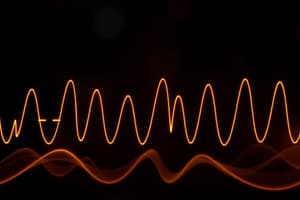Podcast
Questions and Answers
What determines the frequency in a mass-spring system?
What determines the frequency in a mass-spring system?
- The color of the spring
- The mass attached to the spring and the spring constant (correct)
- The material of the spring
- The length of the spring
Which of the following factors does NOT determine frequency in an electrical circuit?
Which of the following factors does NOT determine frequency in an electrical circuit?
- Voltage (correct)
- Resistance
- Capacitance
- Inductance
What type of oscillations have external influences that affect the amplitude or frequency?
What type of oscillations have external influences that affect the amplitude or frequency?
- Simple harmonic motion
- Damped or forced oscillations (correct)
- Stable oscillations
- Undamped oscillations
How are oscillations used in communication systems?
How are oscillations used in communication systems?
What type of motion results in displacement proportional to the sine or cosine of the angle?
What type of motion results in displacement proportional to the sine or cosine of the angle?
Why is knowing frequency essential in understanding the applications of oscillations?
Why is knowing frequency essential in understanding the applications of oscillations?
What does frequency measure in an oscillating system?
What does frequency measure in an oscillating system?
If a pendulum completes 4 full swings in one second, what is its frequency?
If a pendulum completes 4 full swings in one second, what is its frequency?
How is frequency related to the period of an oscillation?
How is frequency related to the period of an oscillation?
If an oscillating function has a period of 0.5 seconds, what is its frequency?
If an oscillating function has a period of 0.5 seconds, what is its frequency?
What is the unit typically used to measure frequency?
What is the unit typically used to measure frequency?
How does an increase in frequency affect the speed of oscillations?
How does an increase in frequency affect the speed of oscillations?
Flashcards are hidden until you start studying
Study Notes
Exploring Oscillations: A Deeper Look at Frequency
Oscillations are all around us, from the ticking of a clock to the rhythm of your heartbeat. They're characterized by a back-and-forth or up-and-down motion, repeating themselves at regular intervals. In this article, we'll dive into the fundamental aspect of oscillations: frequency.
Defining Frequency
Frequency is the number of oscillations or cycles completed by a system per unit time, often measured in hertz (Hz). Think of it like this: if a pendulum swings back and forth once every second, its frequency is 1 Hz. The greater the frequency, the faster the oscillations.
Frequency Measurement
The frequency of an oscillating system can be measured using several methods. One common method involves counting the number of cycles completed in a given time interval. For example, if you observe a pendulum swinging back and forth for one second and find that it completes 3 full swings, its frequency is 3 Hz. You can also use a simple formula:
[ frequency = \frac{1}{time\ interval} ]
For instance, if a function has a period of (0.2) seconds, its frequency is (1/0.2 = 5) Hz.
Period and Relation with Frequency
The period of an oscillation is the time it takes for the system to complete one full cycle. The relationship between period and frequency is inverse:
[ frequency = \frac{1}{period} ]
Influence of Parameters on Frequency
The frequency of an oscillating system can be influenced by various factors. For example, in a mass-spring system, the frequency is determined by the mass attached to the spring and the spring constant. In an electrical circuit, the frequency is determined by the inductance, capacitance, and resistance of the circuit components.
Types of Oscillations
Oscillations can be classified as simple harmonic motion, where the displacement is proportional to the sine or cosine of the angle, or as damped or forced oscillations, where there are external influences that affect the amplitude or frequency of the oscillations.
Applications of Oscillations
Oscillations play an important role in various fields. From musical instruments to communication systems, oscillations are ubiquitous. For instance, the vibrations of a string in a musical instrument produce sound waves that we perceive as musical notes. In communication systems, oscillations are used to transmit information in the form of data packets.
Summary
In this article, we explored oscillations and their most fundamental aspect: frequency. We learned how to define, measure, and calculate frequency. We also touched upon the relation between frequency and period, as well as the factors that influence frequency. This knowledge is essential to understanding the diverse applications of oscillations in various fields.
Studying That Suits You
Use AI to generate personalized quizzes and flashcards to suit your learning preferences.




